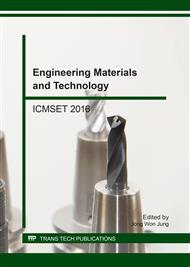[1]
R. Morales, J. M. Alameda, J. V. Anguita, J. I. Mart, J. I. Martin, M. Velez, F. Briones, J. L. Vicent, Fabrication and magnetic properties of arrays of amorphous and polycrystalline ferromagnetic nanowires obtained by electron beam lithography, J. Magn. Magn. Mater. 249 (2002).
DOI: 10.1016/s0304-8853(02)00524-3
Google Scholar
[2]
W. Wang, H. Ke, J. C. Rao, M. Feng, Y. Zhou, Sol–gel synthesis of SrBi2Ta2O9 nanowires, J. Alloys Compd. 504 (2010) 367–370.
DOI: 10.1016/j.jallcom.2010.05.118
Google Scholar
[3]
M. Zhu, X. Chen, Z. Wang, Y. Chen, D. Ma, H. Peng, J. Zhang, Structural and optical characteristics of silicon nanowires fabricated by wet chemical etching, Chem. Phys. Lett. 511 (2011) 106–109.
DOI: 10.1016/j.cplett.2011.06.013
Google Scholar
[4]
G. Zhou, Z. Zhang, D. Yu, Growth morphology and micro-structural aspects of Si nanowires synthesized by laser ablation, J. Cryst. Growth 197 (1999)129–135.
DOI: 10.1016/s0022-0248(98)00929-4
Google Scholar
[5]
G. D. Sulka, L. Zaraska, W. J. Stpniowski, Encyclopedia of Nanoscience and Nanotechnology 2nd Edition, in: H. S. Nalwa (ed. ), American Scientific Publishers (2004).
Google Scholar
[6]
J. P. O'Sullivan, G. C. Wood, The morphology and mechanism of formation of porous anodic films on aluminium, Proc. R. Soc. A: Math. Phys. Eng. Sci. 317 (1970) 511–543.
Google Scholar
[7]
G. D. Sulka, W. J. Stepniowski, Structural features of self-organized nanopore arrays formed by anodization of aluminium in oxalic acid at relatively high temperatures, Electrochim. Acta 54 (2009) 3683-3691.
DOI: 10.1016/j.electacta.2009.01.046
Google Scholar
[8]
W. J. Stępniowski, Z. Bojar, Synthesis of anodic aluminium oxide (AAO) at relatively high temperatures. Study of the influence of anodization conditions on the alumina structural features, Surf. Coat. Tech. 206 (2011) 265–272.
DOI: 10.1016/j.surfcoat.2011.07.020
Google Scholar
[9]
W. J. Stępniowski, D. Zasada, Z. Bojar, first step of anodization influences the final nanopore arrangement in anodized alumina, Surf. Coat. Tech. 206 (2011) 1416–1422.
DOI: 10.1016/j.surfcoat.2011.09.004
Google Scholar
[10]
H. Segawa, H. Okano, K. Wada, S. Inoue, Fabrication of alumina films with laminated structures by ac anodization, Sci. Tech. Adv. Mater. 15 (2014) 014209 1-10.
DOI: 10.1088/1468-6996/15/1/014209
Google Scholar
[11]
C. Dorrer, J. Ruhe, Some thoughts on superhydrophobic wetting, Soft Matter. 5 (2009) 51–56.
Google Scholar
[12]
E. Lalik, R. Kosydar, R. Tokarz-Sobieraj, M. Witko, T. Szumełda, M. Kołodziej, W. Rojek, T. Machej, E. Bielańska, A. Drelinkiewicz, Humidity induced deactivation of Al2O3 and SiO2 supported Pd, Pt, Pd-Pt catalysts in H2 + O2 recombination reaction: The catalytic, microcalorimetric and DFT studies, Appl. Catal. A: General 501 (2015).
DOI: 10.1016/j.apcata.2015.04.029
Google Scholar
[13]
C. R. Zamarreno, J. Bravo, J. Goicoechea, I. R. Matias, F. J. Arregui, Response time enhancement of pH sensing films by means of hydrophilic nanostructured coatings, Sens. Actuat. B 128 (2007) 138–144.
DOI: 10.1016/j.snb.2007.05.046
Google Scholar
[14]
C. H. Voon, M. N. Derman, U. Hashim, K. R. Ahmad, K. L. Foo, Effect of Temperature of Oxalic Acid on the Fabrication of Porous Anodic Alumina from Al-Mn Alloys, J. Nanomater. 2013 (2013) 1-8.
DOI: 10.1155/2013/167047
Google Scholar
[15]
F. Blaffart, Q. Van Overmeere, T. Pardoen, J. Proost, In situ monitoring of electrostriction in anodic and thermal silicon dioxide thin films, Journal of Solid State Electrochemistry 17 (2013) 1945-(1954).
DOI: 10.1007/s10008-013-2036-0
Google Scholar
[16]
A. Nazemi, A. Najafian, S. A. S. Sadjadi, Aluminium oxide nanowires synthesis from high purity aluminium films via two-step anodization, Superlatt. Microstruct. 81 (2015) 1–6.
DOI: 10.1016/j.spmi.2015.01.013
Google Scholar
[17]
J. Liu, S. Liu, H. Zhoua, C. Xie, Z. Huang, C. Fu, Y. Kuang, Preparation of self-ordered nanoporous anodic aluminium oxide membranes by combination of hard anodization and mild anodization, Thin Solid Films 552 (2013) 75–81.
DOI: 10.1016/j.tsf.2013.12.023
Google Scholar


